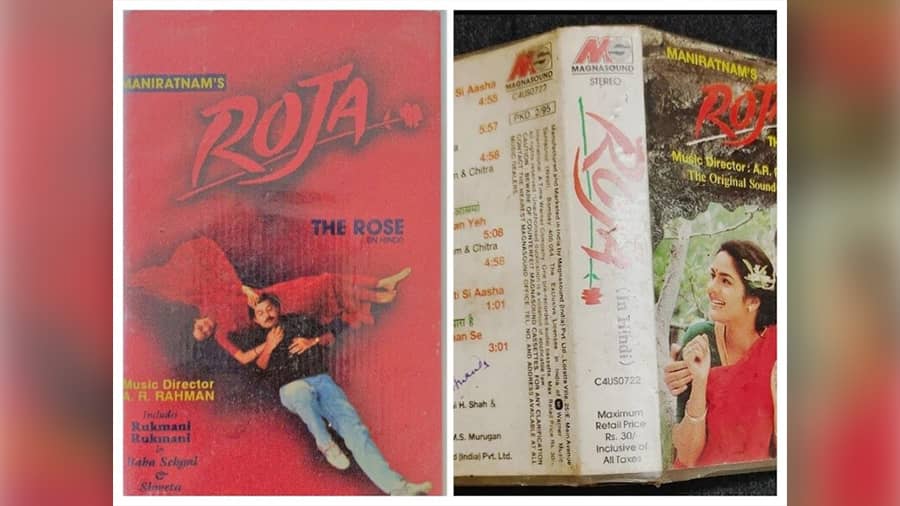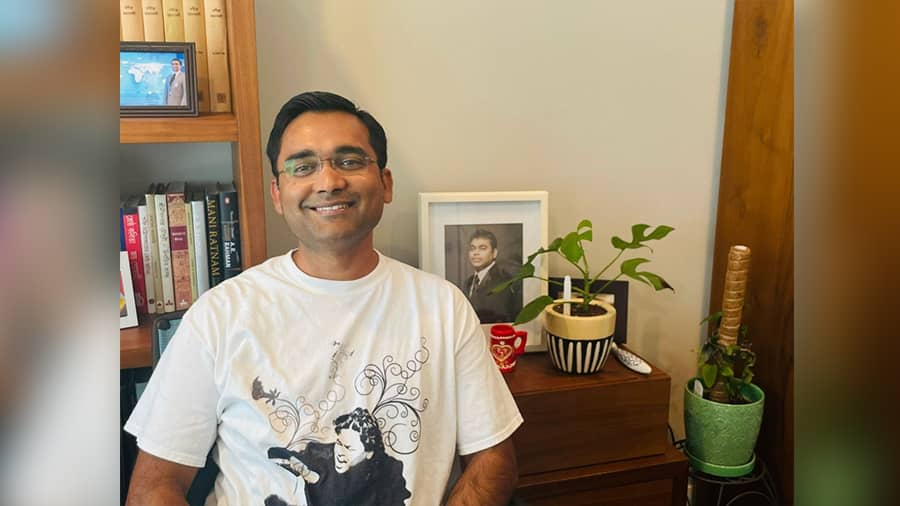It was August 15, 1992, when Mani Ratnam’s Roja hit the silver screens in Tamil Nadu. A riveting love saga set against the backdrop of violent insurgency in Jammu and Kashmir, Roja remains a major milestone in the history of Indian cinema. The strong portrayal of the female protagonist, who grew up in rural Tamil Nadu and then fought against all odds to rescue her husband in another corner of the country – transcending all barriers of language and culture – literal and metaphorical, captivated the nation. If you ever thought the current trend of ‘pan-India’ films is a new phenomenon, think again. Dubbed in Hindi and released a year later, Roja was a runaway hit across India and set new standards of storytelling for generations of moviemakers and technicians to come.
What also changed, forever, with the arrival of Roja was how Indian film music was composed, recorded, and presented. I was in my early teens, growing up in Behala, Kolkata, in a quintessential Bengali household and neighbourhood, when someone in my afterschool tuition classes introduced me to a cassette tape of Roja. The cover itself stood out. Unlike most other films at that time that would have all kind of colours and hues, and multiple portraits of the stars (almost invariably male), with what I thought were over-the-top expressions, here was a soothing image of a couple in loving company of each other, with the female lead in a red sari, matching the colour tone of the cover, likely signifying the central role of her character in the story.
I got back home that rainy evening and played the songs on my Walkman cassette player. I was stunned. It sounded refreshingly new, and yet there was a feeling that this was the kind of music my generation was waiting to hear. All the compositions were remarkably different in their flow, orchestration, use of vocals and choice of instruments, and the more I listened to them, I could discover newer layers. My immersive journey with the creative genius of A.R. Rahman started that evening. A spell was cast.

I had two sets of Roja cassettes at home: a back-up was ready if I had to give one to a friend, temporarily
Photo courtesy: Suvra and Avra Sankar BandyopadhyayThe impact
Early 1990s in India was a fascinating period. Doordarshan, with its two-ish channels, was the primary source of audio-visual entertainment. Newspapers were our windows to the world of politics, sports and crosswords. While most of such media were monochromatic (and arguably less dramatic than they are now), our real surroundings, people, and relations added the true colours to our formative years. Exposure to film music was restricted to Chitrahaar, which aired on national television every Wednesday evening for about half an hour, often interrupted – not by advertisements, but by power cuts or ‘load-sheddings’. During this time, India as a nation was also going through a climacteric – economic reforms and globalisation, expansion of information technology and introduction to computer sciences and their application in daily lives – all that would eventually change our way of living were just taking baby steps.
Amidst all of these, my quest to know more about A.R. Rahman and his music began. Post Roja, nothing in the conventional Hindi or Bengali film music scene would come close to the bar Rahman had already set. Although the brilliance of ‘Tomake Chai’ and the subsequent series of private, non-film albums by Kabir Suman, and a few other singers got our generation back to listening to modern Bengali songs, the primary appeal of these songs, at least to me, were in the lyrics and poetry associated with them.
Living in Kolkata, and being a school-going kid, I had major restrictions in terms of access to information about A. R. Rahman and his works. All through the 90s, Rahman was rather reclusive, and seldom seen in television interviews. There would just be occasional newspaper articles, noting the buzz around this new composer. The primary interface between him and us were through his work. But much before the next Hindi (dubbed) album – Bombay (1995) – would be available in music stores, I found my way to Rahman’s Tamil original scores. I learned from my network of friends that there were a few stores in Kolkata that sold Tamil cassettes. A grocery store, of all places, in Behala had a small shelf for such cassettes, and the iconic music store Melody at Rashbehari crossing in South Kolkata also had a section for regional albums – these two became my gateway to Rahman’s work in Tamil and Telugu. And I could tell I was not alone.
Albums such as Thiruda Thiruda (1993) and its songs – Veerapandi Kottayyile and Konjum Nilavu – were playing in television shows such as the ‘Superhit Muqabla’ that did not usually play non-Hindi scores. To me, this was the turning point of India waking up to the storm that Rahman was creating from his studio in Chennai. Moreover, as a prominent deviation to the hyperbole prevalent in the showbiz and music industry back then, his music was doing the talking – language no bar. This was the time I saw my India starting to celebrate creative art forms in its true form, when it comes to mainstream film music, transcending the Himalayan (or Vindhya-n?) language barrier that divided the country for way too long. Before Rangeela (1995) formally shook up the Hindi film industry, Rahman had composed masterpieces in Tamil for albums such as Pudhiya Mugam, The Gentleman, Indira and more.
By this time, going by the ‘epidemic’ of Tamil songs playing round-the-clock in my household, our neighbourhood in Behala was confused. A more friendly section was curious if I was dating a Tamil speaking girl, while another group was furious for the continued sleep disruption from my late-night experiments with Rahman’s anyways experimental scores. My Walkman had given way to a ‘stereo cassette player’ which initially lasted just a few songs – its subwoofers were too primitive to survive the heavy drums and strings of Rahman’s scores. After a few such failed attempts at matchmaking between Rahman’s futuristic beats and a music player, it was my ‘score’ at the state medical entrance exams – no less – that convinced my parents to get me a Sony compact disc player that reproduced Rahman’s tracks with thunderous precision.
Over the subsequent years and decades, Rahman remained omnipresent in my journey of life, as I navigated through college, graduation, and professional career as a public health physician. From falling in love (not with a Tamil-speaking girl, for ‘records’) to excruciating heartbreaks, from getting through the gruelling medical studies to working in rural India as a polio eradication foot-soldier, from tying the proverbial knot to being a parent, and from leaving the motherland to traveling across the world as a global health professional – his creations added value and meaning to every chapter of my life. His songs are embedded in moments of days gone by, and they act as living ‘hyperlinks’ – I could play a tune and get transported to the time when I first heard it and revisit associations with that period – people, incidents, experiences.
The legacy
Rahman had struck a chord with the length and breadth of India with his first album itself. The subsequent years saw Rahman consolidate his place as a pan-India composer. Rahman would unapologetically celebrate his rootedness in Tamil culture, and generate one chartbuster after the other, including in Hindi. He would record primarily from his studio in Chennai, where singers from all over the country had to fly in and record in wee hours. A distinct character of Rahman’s compositions has been in the confluence of various forms of music – from folksy to funky, from ragas to reggae, and from Hindustani classical to hip-hop – there is hardly any gharana of music that Rahman has not been able to adapt to make them sound appealing. Rahman moved much beyond the mechanics of fusion music and has consistently been able to create unique melodies that have re-defined the musical formats and song structures.
Rahman’s experiments with vocals, humming and chorus brought a whole new dimension to film music – the haunting background vocals of Shankar Mahadevan in the riot scenes in Bombay, the use of acapella in Rasaathi in Thiruda Thiruda and the very recent use of Arijit Singh’s voice in two different layers in the mellifluous Agar Tum Saath Ho in Tamasha – are glorious examples.
Across all his creations over the years, what has kept a Rahman score apart from others is probably his distinct sense of aesthetics. Even the most frivolous of songs or situations would have that special treatment that adds a sense of purity and divinity to elevate the appeal of the composition. With Rahman’s flair with sound mixing, even traditional instruments such as flute, shehnai and sitar would sound endearingly different. It was also with Rahman, that we saw technicians and artists get due acknowledgement: Sivamani (percussion), Naveen Kumar (flute), Mohini Dey (electric bass) and others became household names thanks to Rahman’s magnanimity in nurturing and portraying his team’s talent on and off stage. Finally, Rahman stands out as an Indian composer with undisputable originality in his approach to his compositions. No other composer in the mainstream Indian film music scene can possibly match how Rahman has consistently stayed relevant with critical and commercial acclaim while staying miles away from the plague of plagiarism. His global recognition with multiple Grammy, Golden Globe and Academy awards is a testament to this, in addition to being a recognition of his creative genius.
To me, Rahman exemplifies the aspirations and characteristics of Next Gen India. He has shown us one can be grounded and yet scale new heights. One can be rooted in humble beginnings, and yet transcend all boundaries. Rahman’s work, his persona, and his success make him an icon par excellence for future generations to celebrate and get inspired from. Jai Ho!

The author, Dr. Ananda Sankar Bandyopadhyay, at his Seattle residence P
hoto courtesy: Sohini Saha BandyopadhyayDr. Ananda Sankar Bandyopadhyay is a global expert in infectious disease epidemiology and vaccinology. He has written peer-reviewed articles, book chapters and perspectives in leading journals, newspapers, and media portals across the world. You can reach him on Twitter: @anandaonline






